Elevate Your Baking Game: Key Skills to Master
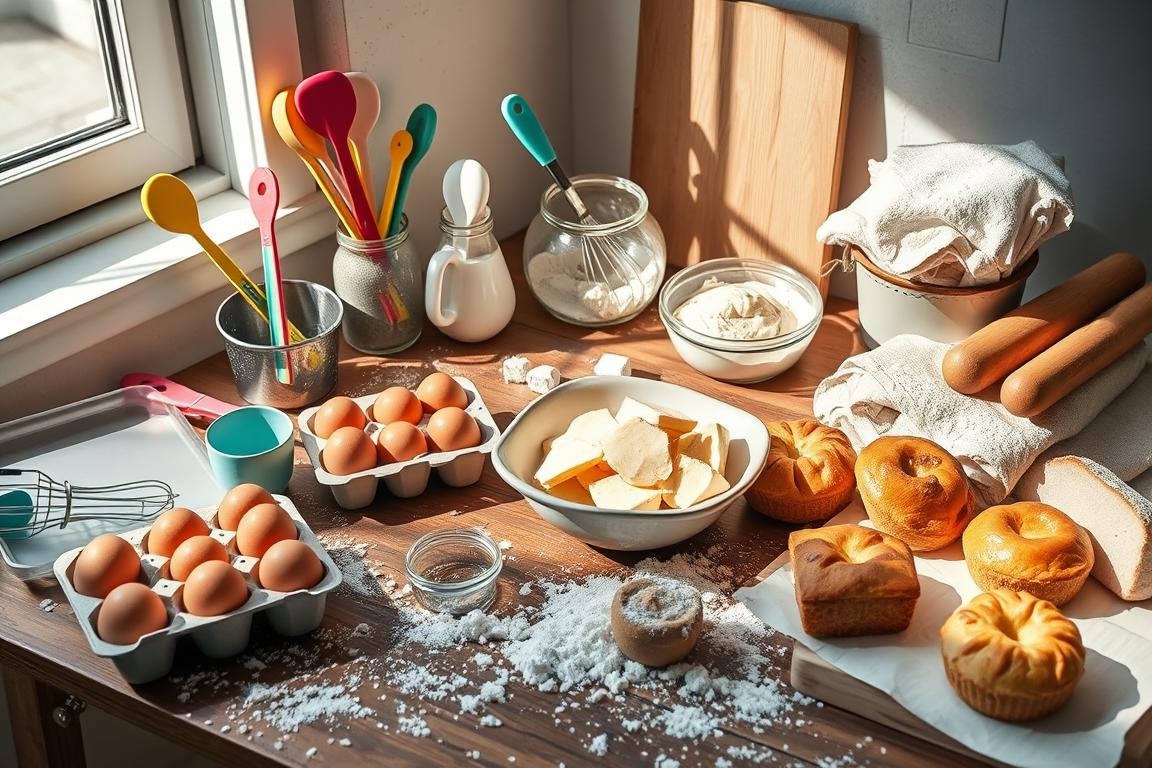
Ever noticed how some bakers make stunning cakes that could be in a gallery? Others find it hard to make their desserts look good on Instagram. Mastering key baking skills is the secret. Social media and food blogs have sparked new creativity in cake decorating. As a result, creating artistic cake designs is now a fundamental skill. Whether you’re already good at easy baking or starting fresh, here is where you begin. Moving from simple to complex cakes with sugar flowers and more begins with learning the basics. You’ll learn where to focus your efforts.
Choosing the right tools and perfecting chocolate work are just the start. These basics are your foundation for making creative cakes. Making sculpted cakes and edible 3D toppers requires patience and skill. This isn’t always shared by famous bakers on social media. Don’t forget the core of baking: good ingredients, careful mixing, and the right temperature. These secrets lead to great baking skills and the joy of making amazing treats for any event.
Key Takeaways
- Understanding the importance of key tools in baking, such as silicone baking mats for even heat distribution and non-stick surfaces.
- Realizing the significance of precise ingredient measurements using measuring cups and spoons to guarantee successful recipes.
- Knowing the role of whisks in incorporating air, blending, and aerating ingredients for the perfect texture.
- Appreciating the critical impact of selecting the correct cake pan for the baking process.
- Implementing high-altitude baking adjustments for consistent results, regardless of your kitchen’s elevation.
- Discovering the value of weighing ingredients and using room temperature components to enhance the quality of baked goods.
Understanding the Science of Baking
Baking is more than just following recipes. It’s about learning the baking fundamentals that turn simple ingredients into tasty treats. Dive into the culinary science with baking techniques for beginners. Knowing how temperature, ingredient interactions, and leavening agents work will make you a better baker.
How Ingredients Interact
At the core of simple baking methods, is how ingredients work together. They combine in a special way to form textures and flavors. For beginners, remember that good ingredients matter. Making changes can cause surprises.
Creaming butter and sugar does more than mix. It adds air for light, fluffy cakes. Properly kneading flour makes bread elastic and stretchy.
Temperature and Its Effects
Controlling temperature is key to good baking. The Maillard reaction makes baked goods golden and tasty. It needs the right heat.
The Role of Leavening Agents
Leavening agents like yeast and baking soda are crucial. Yeast makes dough rise by fermenting sugars. Baking soda makes cakes and quick breads light and airy.
Knowing these reactions combines science and art in baking. It makes baking a fulfilling adventure. So, get ready to explore the wonders of baking.
Essential Equipment Every Baker Needs
Starting your baking journey? The right tools are key. Whether you’re trying easy baking recipes or complex pastries, you need good tools. Here are the baking essentials for starters you should get.
Must-Have Tools for Beginners
If you’re new to baking, getting good gear is important. It helps you make everything from cookies to cakes. Here are the basic tools you’ll need:
- Measuring cups and spoons: Go for OXO with magnetic handles. They are made of strong stainless steel.
- Mixing bowls: OXO Good Grips are the best for lasting and easy use.
- Silicone spatulas: These are the top choice for mixing well. They are key for baking fundamentals.
- Oven mitts: Pick Big Red House mitts. They’re top among 20 brands.
- Silicone baking mats and pans: They prevent sticking and heat evenly. They’re vital for baking.
Upgrading Your Baking Gear
Once you’ve mastered the basics, better gear can make baking more fun. It can also make your baked goods better. Consider these highly rated items:
- KitchenAid Pro line stand mixer: It’s strong and perfect for big baking jobs. It holds 7 quarts.
- Breville hand mixer: With powerful 240 watts, it works great for thick doughs.
- Bread cloche: The Challengerbreadware model is the best for baking bread like a pro.
- All-Clad 3-quart saucepan: Known as the kitchen’s workhorse, it’s great for melting chocolate or making custards.
Safety and Maintenance Tips
Keeping your baking tools in good shape is important for safety and to make them last. Here’s how:
- Always wash your silicone mats and pans right after using them. This stops residue buildup.
- Keep sharp tools safe. Store spatulas away from heat to avoid melting them.
- Check scales and thermometers often. You want them to give correct readings for perfect recipes.
| Tool | Brand | Recommended Quantity | Notable Features |
|---|---|---|---|
| Hand mixer | Breville | 1 | 240 watts power, ideal for most baking tasks |
| Bread cloche | Challengerbreadware | 1 | Priced at $299, best for artisan breads |
| Oven mitts | Big Red House | 1 pair | Heat resistant, secure grip |
| Kitchen scale | OXO | 1 | Priced at $55, most accurate measurement |
| Stand mixer | KitchenAid Pro line | 1 | 7-quart capacity, $700, for serious bakers |
With these tools, you’re ready to dive into easy baking recipes and more. Your baking adventure will be fun and rewarding.
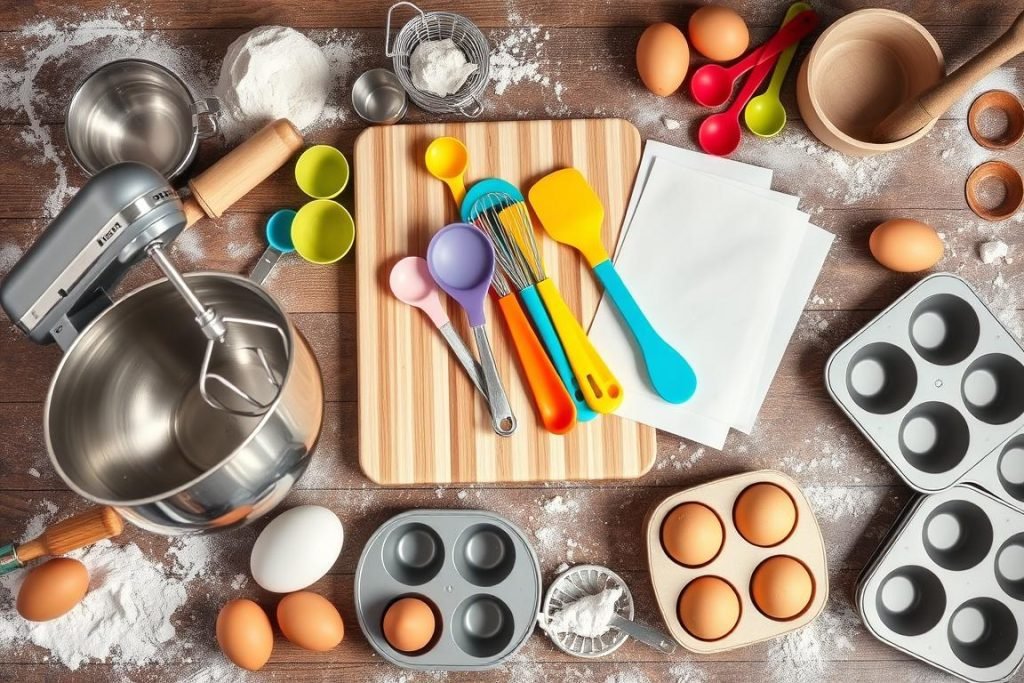
Mastering Fundamental Techniques
Starting to bake means learning some key skills first. This part gives you beginner-friendly baking hacks and baking tips for novices. They will make baking easier and more fun for you.
Mixing Methods Explained
Each way of mixing has its own role. For example, creaming mixes sugar and butter. This adds air and makes cakes soft. Folding is mixing gently. It keeps fluffy ingredients like egg whites light in the batter. Knowing these baking techniques for beginners is important. They help make your baked goods just right.
Measuring Ingredients Accurately
Measuring ingredients right is very important in baking. Even a little too much or too little can change everything. It can make your baking turn out not as expected.
For example:
| Ingredient | Purpose | Measurement Tip |
|---|---|---|
| Flour | Structure | Spoon into cup and level off |
| Sugar | Sweetness and texture | Scoop and sweep level |
| Baking Soda | Leavening agent | Accurate pinch for balance |
Kneading and Shaping Dough
Kneading dough is an art you’ll get better at with time. It’s for making the dough’s gluten. This gives bread its feel and look. For bread or pastry, start kneading softly but firmly. Baking tips for novices say this is the way to go. Your dough should feel smooth and a bit sticky when ready.
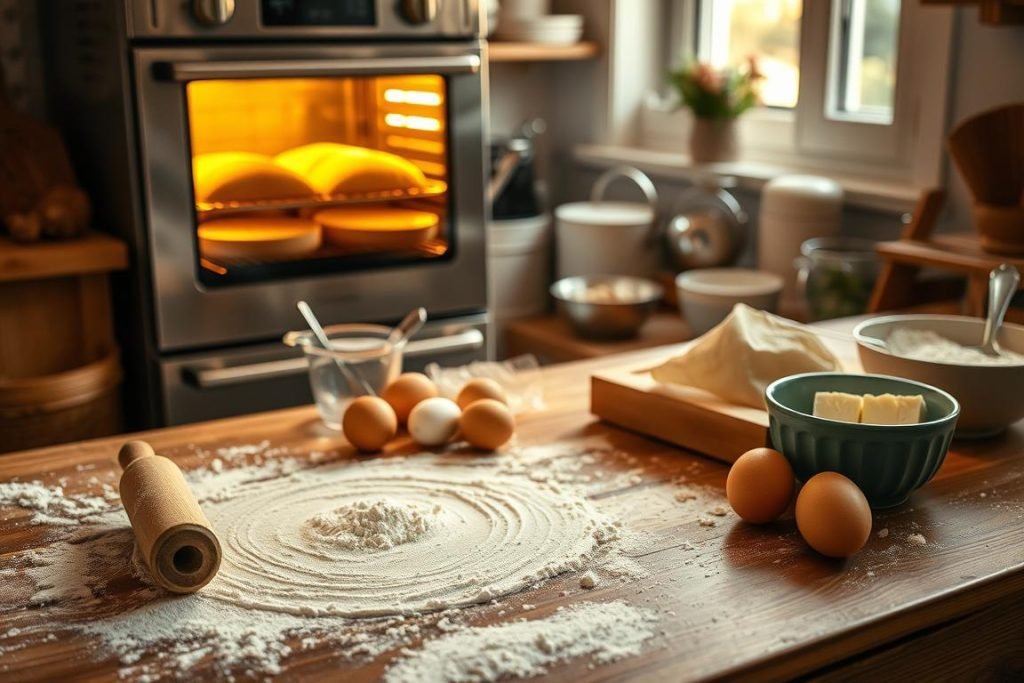
Shaping dough is also key. It decides how your bread or pastries will look in the end. Doing it right means your baking will not only taste great. It will also look like it’s made by a pro.
Using these tips and baking techniques for beginners will help you get better faster. Keep going and practice a lot. Soon, these skills will be easy for you when you bake.
The Importance of Baking Temperatures
Getting baking right starts with knowing how important temperature is. Whether you’re new to baking or learning more, controlling temperature is key. It can change how your baking turns out. Making sure your oven is hot enough before you start is important. Using things like an oven thermometer can really make your baking better. Temperature control can make your baking recipes better and improve your skills.
Preheating Your Oven Correctly
Preheating your oven is the first step to good baking. It makes sure your oven is hot enough, which is very important. You need to let your oven get evenly hot before you bake. This helps your food bake well.
Using an Oven Thermometer
An oven thermometer is very useful for baking well. Oven settings might not be right, making your food cook unevenly. An oven thermometer gives you the real temperature inside your oven. It helps you change settings if you need to. This tool is very important for bakers. It lets you trust your oven’s temperature.
Impact of Temperature on Texture
Temperature really affects how your baking feels. The right temperature can make cakes fluffy or pastries crisp. Knowing how heat works with what you’re baking helps you get the texture you want every time.
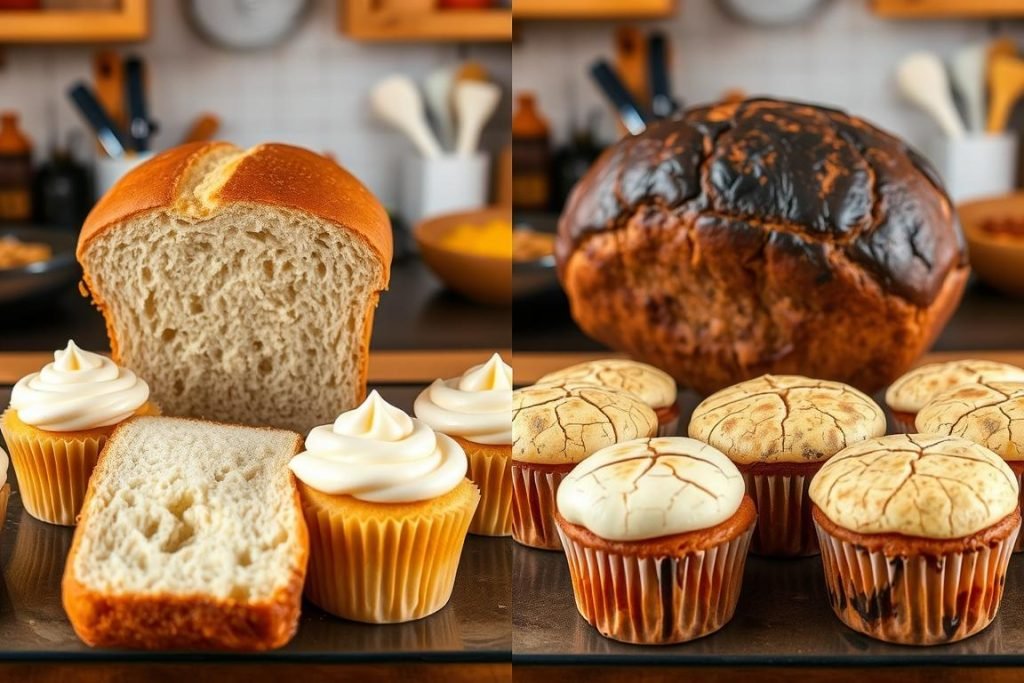
| Baked Good | Optimal Baking Temperature | Common Adjustments |
|---|---|---|
| French Baguette | 425°F (220°C) | May need lower temp in convection ovens |
| Sourdough | 450°F (230°C) | Use steam for better crust |
| Whole Wheat Bread | 375°F (190°C) | Shorter baking time to prevent drying |
| Brioche | 350°F (175°C) | Rotate for even baking |
Using what you learn about baking makes your food better and baking more fun. Being precise makes baking perfect for beginners. Keep trying with different temperatures and times. This helps you find what works best for your oven and recipes. Every time you bake can be a fun food adventure.
Creating Perfect Doughs and Batters
Starting to bake mixes science and art. You’ll want to learn about making smooth batters and stretchy dough. It’s important to know the types and how to work with them. This know-how improves your baking and makes every baked good a delight.
Types of Dough and Their Uses
Doughs differ a lot in texture and purpose. Knowing this is essential for baking essentials for starters. For bread, yeast dough is best because it rises well. But for pies and tarts, a flaky shortcrust dough is better. Each type needs its own handling and ingredient balance. This is basic knowledge for those learning baking basics.
Tips for Making Fluffy Batters
If you’re a beginner, making a light batter means learning a few simple baking methods. Sift dry ingredients to add air. Don’t over-mix after adding wet ingredients. Folding gently keeps the air bubbles that make the batter rise. This moves your skills from simple to skilled.
Understanding Gluten Development
Gluten makes or breaks a bake, making it tough or tender. Knowing how much to mix and knead is key. This is a vital baking tip for novices. Overworking the dough makes it chewy. But handle it just a little, and you get a soft, tender bake.
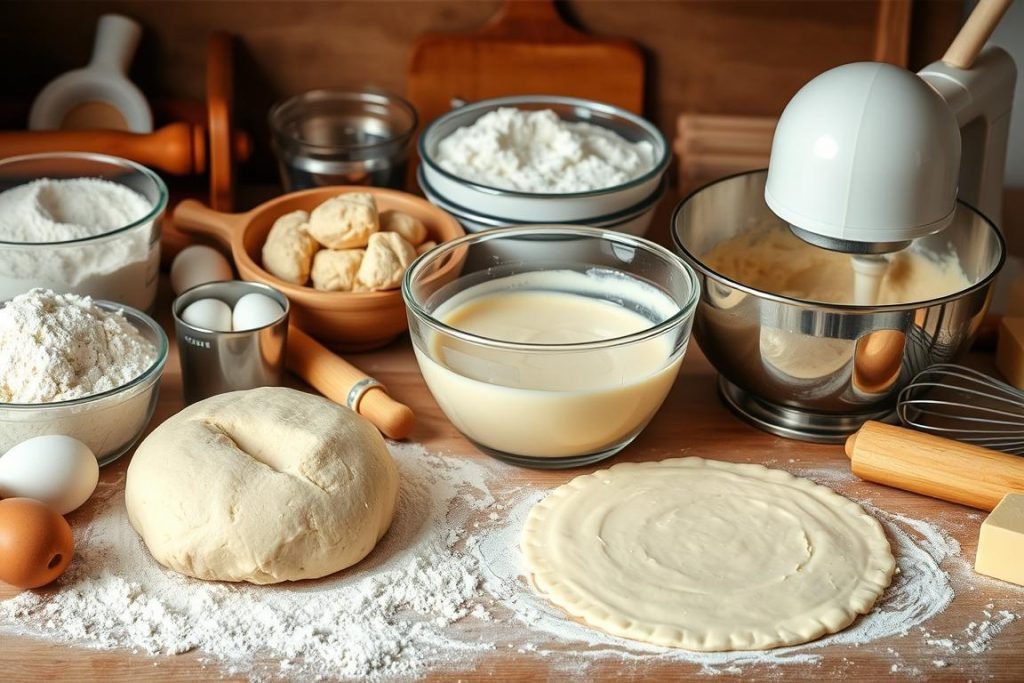
| Ingredient Measurement | Quality Ingredients | Adjustments for Altitude |
|---|---|---|
| Measure right to avoid dryness; don’t guess a cup of flour. | Choose brands like King Arthur Flour for better structure. | At high elevations, bake hotter and tweak the recipe. |
| Test your oven’s heat for even baking. | Online reviews offer extra baking advice. | Change sugar and liquid amounts for your high place for best results. |
As you dive deeper into baking’s art and science, every batch teaches you. It shows you more about working dough and batter, leading you to be skilled in the kitchen.
The Art of Cake Baking
Learning to bake cakes well makes your homemade desserts better. It also helps you learn key baking techniques for beginners. Whether you’re starting or improving your cake decorating, knowing these basics is important.
Choosing the Right Flour for Cakes
The type of flour you use changes your cake’s texture. Cake flour works best for a soft cake. It has less protein, making cakes soft and light. This choice is crucial for great cakes, especially for new bakers.
Techniques for Leveling Cakes
Even cake layers are key for looks and stability. A serrated knife levels the cake top right. It’s a must-know for beginners, ensuring tiered cakes are stable and look good.
Frosting and Decorating Basics
Frosting is both glue and art for cakes. Learning to apply buttercream smoothly is basic. Cake decorating turns simple cakes into works of art. You can add piping, textures, and fondant as you get better.
| Aspect | Details | Importance |
|---|---|---|
| Flour Type | Cake flour for soft texture | Essential for tender crumb |
| Leveling Technique | Use of serrated knife | Crucial for layered cakes |
| Decorating Skills | Starting with smooth buttercream | Base for advanced decorating |
Adding these skills to your baking can make you more sure of yourself in the kitchen. With each layer and frosting swirl, you show your baking art. It invites you to try more in cake baking and decorating.
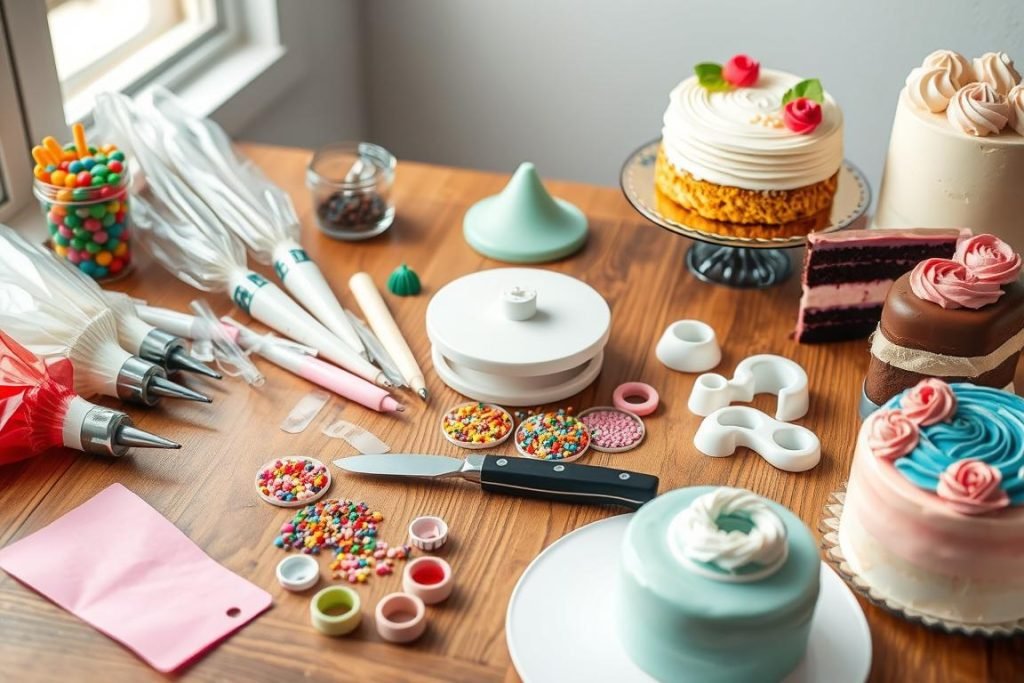
Exploring Bread Baking Skills
Are you starting to make bread? Learn a few key techniques first. Knowing the differences between bread types helps a lot. We will look at what makes sourdough and yeast breads different. We’ll also discuss why proofing is important, and what makes a great crust and crumb.
Sourdough vs. Yeast Bread
Sourdough and yeast breads taste and feel different. This is important for new bakers to know. Yeast breads rise fast and have a consistent texture, which is good for beginners. Sourdough has a natural starter, giving a tangy flavor and chewy texture. It takes time but makes bread taste amazing and have a firm crust.
Mastering the Proofing Process
The proofing stage is key in bread making. It’s where the dough rises to get the perfect texture and flavor. The goal is to make the bread airy but firm. Getting this part right is very important. Different breads need different proofing. Your patience and practice matter a lot here.
Crust and Crumb: What You Need to Know
For great homemade bread, get the crust and crumb right. The crust should be golden and crispy. The crumb is the inside of the bread. It should be soft, yet well-formed, with air pockets. Getting these parts right makes your bread special.
Understanding bread making basics is helpful. It’s more than just skills. It’s also about the science behind ingredients and their processes.
| Skill | Importance |
|---|---|
| Shaping and Scoring Bread | 100% Essential |
| Caramelizing Sugar | Vital for Beautiful Bakes |
| Tempering Chocolate | Defines Texture, Shine, and Durability |
| Melting Chocolate Difficulty Level | Higher for White Chocolate |
| Mastering Candy-making Stages | Key to Successful Glazes |
Learning to nurture a sourdough starter and work with yeast can be fun and educational. With these tips and dedication to learning, you’re on your way to becoming great at making bread.
Pastry Skills for the Home Baker
Starting with pastry might feel scary. But, focusing on baking fundamentals and simple baking methods helps a lot. Even if you’re new, you can make amazing pastries. Learning baking techniques for beginners will let you turn simple stuff into great desserts.
Techniques for Shortcrust Pastry
Making shortcrust pastry is key for lots of desserts. It needs you to be careful and patient. The trick is keeping the butter cold and not overmixing. This way, you get that flaky texture.
Being exact with your measurements is important. Small mistakes can mess up the crust.
Laminating Dough for Flakiness
Laminating dough makes pastries like croissants flaky. You fold butter into the dough over and over. This gives the pastry a light, layered feel. It shows how basic baking fundamentals help in making complex treats. Patience and keeping things cool are key to great lamination.
Common Pastry Mistakes to Avoid
Many new pastry cooks make mistakes. They might overwork the dough or not chill it right. These problems usually happen when you’re in a hurry or overlook the need for precise temperature.
But you’ll get better with practice and repetition. Remember, learning from each mistake is part of the journey. Being well prepared and having everything ready is super important. It makes creating pastries easier.
By practicing these skills, you get better at making pastries. You’ll also get better at using your hands and being more adaptable in the kitchen. Turning dough into beautiful, tasty art is rewarding. It makes you love baking even more.
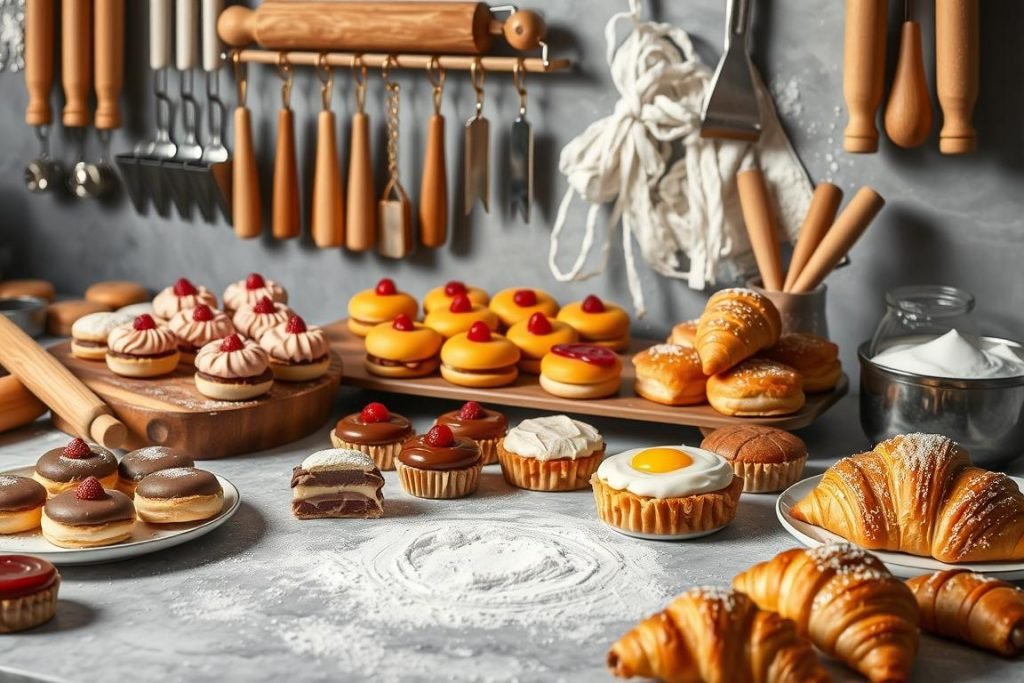
Understanding Baking Times
When starting with baking basics, knowing about baking times is key. This ensures your bakes are always just right. This is true no matter the different factors at play.
Factors Affecting Bake Time
Many things can change how long your food needs to bake. An accurate oven is very important. It makes sure the temperature you set is what the oven actually is. The type and size of your baking pan matter too. Different pans spread heat in their own ways. Also, if your ingredients start cold or warm matters a lot.
Testing for Doneness
Learning how to check if your bake is fully done is important. Using a toothpick to test the middle is a great trick. Looking at the color and how springy it is can also help. This tells you if your food is cooked all the way through.
Making Adjustments Based on Altitude
High altitudes make baking a bit hard. The air pressure is lower up high. So, you might need to change how long you bake, the oven temperature, and recipe amounts. At high places, you often need higher oven temps and shorter baking times.

Being good at baking is more than just timing. It’s about knowing your materials and setting. All bakers, new or experienced, need to keep getting better at this. It’s a big part of making great baked goods.
Advanced Techniques for Flavor Development
Exploring flavor in baking improves your skills and makes every bite special. Learning about flavors is key for beginners. This part will show you how to use spices and herbs. You will get a rich taste in your food.
Infusing Flavors into Your Baked Goods
Infusing flavors is basic but important. It can change how you bake, whether you’re new or experienced. For example, adding vanilla to sugar or lemon to syrup adds special touches to your desserts.
Incorporating Herbs and Spices
Herbs and spices are not just for cooking but baking too. Cinnamon in pies or cardamom in dough makes your food smell amazing. It’s important to know when to add them to get the best flavor.
Understanding Flavor Balancing
Flavor balancing is like a dance. With practice, you can do it well. Think about how different flavors work together, like tart berries and creamy custard.
Knowing when and how to mix flavors makes your baking great. Below is a table of tips from experts to help you learn:

| Technique | Type of Ingredient | Impact on Flavor |
|---|---|---|
| Preheat Oven | N/A | Ensures even cooking and flavor development; cited in 60% of baking instructions |
| Using a kitchen scale | General | Helps measure ingredients precisely for consistent flavors; recommended by 75% of expert bakers |
| Room temperature ingredients | Butter, eggs | Better blending and smoother batter; considered essential in 80% of recipes |
| Add herbs/spices early | Cinnamon, basil | Enhances dish’s aroma and depth; crucial for effective flavor layering |
| Rotate baking pans | N/A | Promotes even browning and consistent results; advised by 85% of professionals |
These tips show that knowing flavor basics is key to baking well. These small things can make a simple recipe a work of art. Start learning these skills, and your baking will show your care and skill.
Crafting Unique Flavor Combinations
Baking is not just about learning the basics. It’s also about mixing flavors creatively. This can help you make unique dishes that show off your style and the seasons.
Pairing Ingredients Thoughtfully
It’s important to know how different ingredients work together. For example, butter’s richness matches well with ginger’s spice. Sugar’s sweetness gets a boost from dark chocolate’s slight bitterness. Learning these pairings can lead to tasty and complex dishes.
Seasonal Flavor Inspirations
Each season offers special ingredients for baking. Autumn has pumpkin and spices like nutmeg and cinnamon for cozy treats. Summer brings citrus and berries for refreshing flavors. Using what the season offers makes your baking tastier and connects it to the natural world.
Experimentation: Finding Your Signature Style
Trying new flavor mixes is key to finding your baking style. This could be using unique spices or mixing sweet with savory. Each try gets you closer to creating your special baked goods.
Let’s check out some common American baking ingredients and their roles:
| Ingredient | Role in Baking | Common Uses |
|---|---|---|
| Butter | Flavor enhancer, texture agent | Cakes, pastries, sauces |
| Sugar (Granulated) | Sweetness, texture adjustment | Cookies, cakes, desserts |
| Flour | Structure and stability | Breads, cakes, pastries |
| Eggs | Moisture, richness, emulsifier | Almost all baked goods |
| Leavening agents (Baking Soda/Powder) | Create rise, airy texture | Cakes, muffins, breads |
| Spices (Cinnamon, Nutmeg) | Flavor enhancement | Pies, spiced cookies, cakes |
| Extracts (Vanilla, Almond) | Intense flavoring | Cakes, cookies, pastries |

Adding icing and fancy plating makes your baking look and taste better. Keep improving your baking skills. Let your passion for baking grow with every dish you create.
Troubleshooting Common Baking Problems
All bakers face challenges, from beginners to experienced ones. About 25% of problems come from changing recipes. When your bake doesn’t go right, fixing mistakes quickly is crucial. Knowing common problems helps make your baked goods delicious.
Fixing Underbaked Goods
Underbaking makes centers doughy and ruins texture. 7% of issues are from not heating the oven right. Make sure your oven is hot enough for even baking. Some cakes need more time to bake just right.
Common Issues with Rising
Getting the perfect rise is hard for bakers. Especially if you’re using gluten-free recipes, which fails 30% of the time. This is often because of measurement issues or not adding xanthan gum. Fresh leavening agents are also key for a good rise.
Remedies for Dry or Dense Products
The right texture is key in baking. But, using different ingredients or pan sizes causes 20% of bakes to fail. And 10% have issues due to the wrong pans. If it’s dry, maybe you mixed too much or measured wrong. Adding a bit more moisture or fat can help make it moist and delicious.